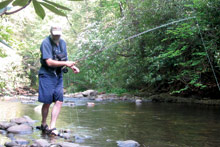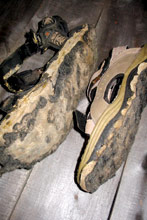When I was in fourth grade, my father gave me my first fly rod: a 9.5 foot, 7-weight Wright & McGill split bamboo. Along with this came a reed creel and a pair of hip boots. I don’t remember my initial reaction to the rod or creel, but I was head over heels with the hip boots. Staying dry while negotiating the meandering spring creeks and beaver ponds in the mountains of northern Colorado felt awesome.

As I grew up, Dad had no problem buying me progressively larger hip boots, but he was adamantly opposed to chest waders. He’d heard stories of strong men drowning while wearing them and was determined that this wouldn’t happen to me. I fished out of sight from Dad a lot, and his theory was that if I was wearing chest waders, I would probably meander into water as deep as they would allow, because I tested the upper limits of my hip boots constantly. He figured hip boots were sort of a governor to keep me from getting in too deep.
By the time I bought my first chest waders, in college, I’d acquired a healthy respect for the power of water currents—and a clear understanding that unfocused people can get themselves into trouble in water not much deeper than their knees.
The issue of wading safety isn’t new. When the first generation of chest waders came into general use, there was much speculation about the danger of people falling in water and having the waders fill up, dragging the luckless angler to an icy demise. On a fall day in the mid-1930s, the warrior god of modern fly-fishing, Lee Wulff, met a photographer and a couple of sports writers on a bridge on the Batten Kill in the Catskills. Wearing unbelted chest waders and clutching a fly rod, Wulff proceeded to dive headfirst into the chilly water 15 feet below; when he surfaced, he rolled on his back, slowly backstroked to shore and crawled out, fly rod in hand.
Conventional wisdom suggests that one should never swim in the ocean where there’s a rip tide, but prepared people swim in these places all the time, knowing that, once trapped, you simply swim parallel to the beach until you’ve escaped the tide. Unprepared people who don’t know this have been swept out to sea and drowned.
Similarly, conventional wisdom says you don’t wear a waterproof garment that’s shaped something like a bucket when you’re near deep water. But anglers armed with the appropriate safety information can extricate themselves from predicaments that might otherwise prove fatal. I misjudge a step periodically when wading and end up getting my upper body wet, but I’ve never fallen in completely wearing waders. That said, I’ve read blogs and viewed videos on YouTube, and I know two people who’ve gone into water headfirst wearing chest waders … and all of them report the same safety information.

Water is no heavier inside chest waders than outside them. But attempting to tread water while wearing filled waders is potential suicide: The combined weight of wet clothing and full waders will pull you under. Raising your legs to the surface and floating on your back or chest will allow a person with reasonably sound swimming skills to get back to shore, provided they don’t panic. And tests have shown that wearing a wader belt will go a long way toward keeping water from filling your waders if you take a spill. In any case, only a fool would wear waders near deep water if they can’t swim and lack an appropriate flotation device.
That said, there’s a lot to like about chest waders: They look cool (and are downright sexy on a woman, if that’s your thing), and they’ll keep your butt dry in cold weather when you sit on wet ground. But in summer, they can be pretty darn hot, not to mention the needless wear and tear on gear that could otherwise be saved for colder temperatures.
About three years ago, I was about to toss a beloved pair of strap-on Teva sandals that had been worn to the nub by gardening and hiking when I had an idea. I could re-glue the split soles and attach outdoor carpet to the bottoms to provide positive traction on slippery stream-bottom rocks. The resulting wading sandals provide a superior level of support and traction (see below).
Here in Western North Carolina, I can comfortably fish in warm weather from May through early October wearing wading sandals and shorts. It’s not the tweed-and-meerschaum style of fly-fishing that translates so well in riverside hero photos, but it works for me.
As for winter safety, however, the big problem—especially now that more folks are fly-fishing our local, delayed-harvest trout waters—is the danger of hypothermia, even if only your upper body gets wet. Since this periodically happens to me, I keep a heavy shirt in a sealed zip-lock bag in the hip pack I wear when I fish in the winter. In my hard-earned experience, you need to get out of a wet shirt as quickly as possible and wring out the water.
A dry shirt has never felt so good as it does on a cold day after an unexpected dip in the drink. Packing an extra one can mean the difference between a relatively uninterrupted day on the river and a hasty retreat. And when packing for a day on the water in cold weather, remember that fleece jackets can be shaken free of excess water and still provide some warmth when wet.
With these cautions firmly in mind, there’s no reason not to sample the joys of cold-weather fishing in WNC.
Directions for making wading sandals can be found at mountainx.com/outdoors.
[Jeff Ashton lives in Weaverville.]



Before you comment
The comments section is here to provide a platform for civil dialogue on the issues we face together as a local community. Xpress is committed to offering this platform for all voices, but when the tone of the discussion gets nasty or strays off topic, we believe many people choose not to participate. Xpress editors are determined to moderate comments to ensure a constructive interchange is maintained. All comments judged not to be in keeping with the spirit of civil discourse will be removed and repeat violators will be banned. See here for our terms of service. Thank you for being part of this effort to promote respectful discussion.